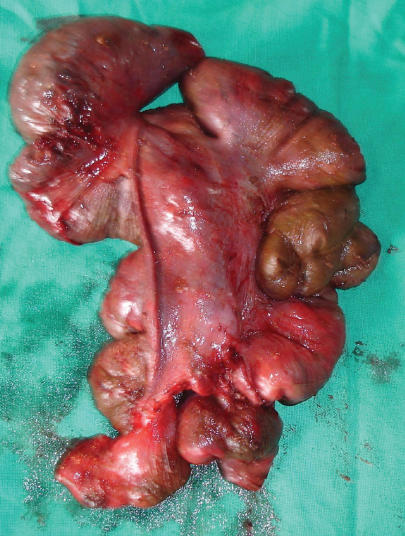A 1.5-year-old Nagauri female calf was presented with a history of an accidental fall into a 4.5-meter-deep dry well. The animal was pulled out of the well and treated with antibiotic and anti-inflammatory injections by a field veterinarian, who also manipulated and tried to reposition the intestines that had prolapsed per rectum. Subsequently, while straining for rectal evacuation, the animal caused the intestines to prolapse again. The animal was referred 36 h later to University Veterinary Teaching Hospital, Ludhiana.
On clinical examination, the animal was standing and walking without any signs of lameness or spinal cord injury. There were a few abrasions on all the legs. However, dark red intestinal loops, about 0.6 m long, were seen hanging through the anus (Figure 1). A per rectal digital examination could not ascertain the site of the rectal tear. The animal was moderately dehydrated and its mucus membranes were congested. Temperature, respiration, and heart rate were within normal limits. Fluid therapy was initiated with isotonic saline solution. The animal was put in left lateral recumbency for a right flank laparotomy under local infiltration anesthesia. On examination of the visceral organs, the rectum was observed to have a tear (about 6 to 8 cm wide) in its ventral wall, through which intestinal loops had herniated and were protruding from the anus. The tear in the rectum was forming a bottle neck, so that the intestinal loops could be pulled neither into the abdomen nor from the anus. The rectal tear was lengthened to about 12 cm. The intestines and mesentery were retracted through rectal tear and then drawn through the laparotomy incision to outside the abdomen. The prolapsed portion of the intestines was blue and showing the signs of necrosis in places.
Figure 1.
Eviscerated intestines hanging out through the anus.
The affected portion of the intestines was resected (Figure 2) and an intestinal anastomosis was performed, using 2-0 Vicryl thread with simple continuous sutures. The rectal tear was also repaired by using appositional sutures. The repaired intestine was repositioned in the peritoneal cavity after flushing it thoroughly with normal saline solution. The peritoneal cavity was also flushed with normal saline solution before closure of the laparotomy incision. The animal was administered ceftriaxone (Cefstan; Ranbaxy Laboratory, New Delhi, India), 10 mg/kg bodyweight (BW), and meloxicam (Melonex; Intas Pharmaceutical, Ahmedabad, India), 0.25 mg/kg BW, IM, q12h for 3 d.
Figure 2.
Resected portion of the eviscerated intestines.
Three hours postsurgery, the animal started passing fecal matter and 6 h post surgery and during the following day took a small amount of liquid. The animal was standing until the 3rd day postsurgery, but then it started to show signs of acute pain and peritonitis (abdominal pain on palpation, rise in body temperature, and labored breathing); it became recumbent and died a few hours later.
Few reports are available in veterinary literature where, in cattle, the intestinal loops have protruded through a rectal tear (1,2) and are hanging out through the anus following accidental trauma. However, a vaginal evisceration of jejunum has been reported in a cow (3).
Various causes for rectal tear include trauma by the veterinarian (iatrogenic), parturition related accidents (dystocia), student or owner manipulation, breeding accidents, trailer accidents, pelvic and vertebral fracture, and spontaneous rupture. But, in the present case, with the accidental fall into a well, the cause of evisceration may have been either trauma to the rectum or spontaneous rupture due to the excessive straining by the animal.
References
- 1.Tyler JW, Shore MD, Croucher BS, Shepard L. Surgical management of rectal and jejunal tear associated with dystocia in a cow. Vet Rec. 1998;143:280–281. doi: 10.1136/vr.143.10.280. [DOI] [PubMed] [Google Scholar]
- 2.Charmillot B. Rectal perforation and jejunal prolapse in a cow Entrectomy. Schweiz Arch Tierheilkd. 1976;118:553–556. [PubMed] [Google Scholar]
- 3.Tulleners EP. Avulsion of jejunum with vaginal evisceration in a cow. J Am Vet Med Assoc. 1984;184:195–196. [PubMed] [Google Scholar]




